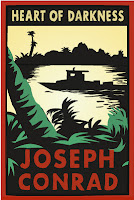Distancing of the Author from the Text and a Scrambling up of the Narrative in terms of Chronology
Joseph Conrad's Heart of Darkness is a masterpiece of modernist literature, renowned for its powerful narrative technique. The novel employs a complex structure that intertwines multiple layers of storytelling, creating a rich and immersive reading experience. In fact, the final years of 19th century saw a change not only in theme but also in the technique of narration. The change in the narrative technique was two fold – the distancing of the author from the text and a scrambling up of the narrative in terms of chronology. Heart of Darkness, utilizes both these techniques and its narrative technique is in perfect harmony with the theme of psychological degeneration depicted in the book In other to prevent Kurtz’s moral fall from lapsing into obtrusive judgement of the author, Conrad presented Kurtz through the eye of at least one other character whom we can guess and from an opinion about. The story opens as a nameless narrator aboard the cruising yawl Nellie, anchored in the Thames River in England, begins to relate secondhand the story of Charlie Marlow's river voyage in the Belgian Congo.
The First Person Narrative
The story in Heart of Darkness is narrated by Marlow, the first person narrator. The ‘core’ of the story is almost primitive in its simplicity. At its core, Heart of Darkness is a frame narrative, in which an unnamed narrator recounts the story of Charles Marlow, a sailor who travels up the Congo River in search of a mysterious figure named Kurtz. Marlow's journey is framed by the narrator's recollections, creating a sense of distance and detachment that heightens the novel's sense of ambiguity and uncertainty. Kutrz, an ivory trader from a European country, ventures into Congo which lies in the heart of the ‘dark continent’ Africa. He soon becomes a very efficient agent but in his bid for exploiting the natures and gradually adopts their savagery, totems and taboos. He wields more power over them that he refuses to leave their company even when he is fill and needs life-saving medicines. But ultimately under compulsion by the European he boards their boat only to die with the words ‘horror’, horror on his lips.
The entire tale is narrated by Marlow who is also the narrator in other Conradian novels like Chance, Lord Jim, and Youth, a Narrative. Initially Marlow, too had been awed by the success of Kurtz no longer remains the ‘disembodied voice’ of a genius but a human being to be judged and commented upon. Marlow had his own system of values and judgment predominant among them being human discipline__ restraint. Thus while speaking of the Negro who jumps up when their boat is attacked by tribal and is killed. Marlow comments on Kurtz:
"He had no restraint, no restraint__ just like
Kurtz___ a tree swayed by the wind."
Again the rituals Kurtz participates in are ‘unspeakable rites’. Marlow makes his own exploration of what he feels is the moral fall of Kurtz:
"The thing is was to know what he belonged to how many
Powers of darkness claimed him for their own."
If Marlow is the first narrator the second narrator a sailor who hears the tale of Kurtz from Marlow and provides his own perspective on both Kurtz and Marlow and even describes his personal reactions. Initially, like Marlow he too, sees everything merged into one colour but gradually with the unraveling of Marlow’s tale, the truth becomes clear. He is, in a way, the audience whom the author is trying to convince.
Disjunction in the True Sequence
The verbal nature of Marlow’s tale makes for yet another narration device- the disjunction in the true sequence. Marlow's tale is disjunctive, with the true sequence of events often obscured. This verbal nature adds to the atmosphere of the novel and highlights the subjectivity of memory and perception. The technique creates a sense of unease and confusion that mirrors the themes of colonialism and imperialism explored in the novel. Although Conrad’s departure from accepted time sequence is not as radical as that of Joyce, Faulkner and Woolf, it is nevertheless a determined step in that direction. The second narrator’s account is not immediate and current but refracted by the memory of a past and distant time. This reconstruction of the past is not linear for there are stray comments about things yet to be realized such as Marlow’s future visit of Kurtz’s ‘Intended’. Conrad also employs a range of literary techniques to create a sense of tension and suspense throughout the novel. The use of vivid imagery, metaphor, and symbolism helps to convey the horror and brutality of the colonial project in Africa, while also exploring broader themes such as the human capacity for evil and the limits of knowledge and understanding.
Conclusion
Overall, Conrad's narrative technique in Heart of Darkness is a powerful example of the modernist literary style. By playing with structure, language, and perspective, Conrad creates a complex and immersive world that invites readers to explore the darkest corners of the human psyche. Thus we find that the narrative technique in Heart of Darkness involves not only a dislocation of time but also two narrators__ an immediate witness and a frame narrator who recounts the heard tale. This serves to give the tale authenticity distances it from any obtrusive authorial design and provides multiple perspectives on the same phenomenon or character.
1.Moonsu Shin. (2009, March). Darkness at the Heart of Anti-Imperialism: Racism in Conrad’s Heart of Darkness. The Journal of English Language and Literature, 55(1), 61–82. https://doi.org/10.15794/jell.2009.55.1.003
2. Renner, S. (1976). Kurtz, Christ, and the Darkness of “Heart of Darkness.” Renascence, 28(2), 95–104. https://doi.org/10.5840/renascence197628217


Comments
Post a Comment
Drop any query, suggestion or comment here.